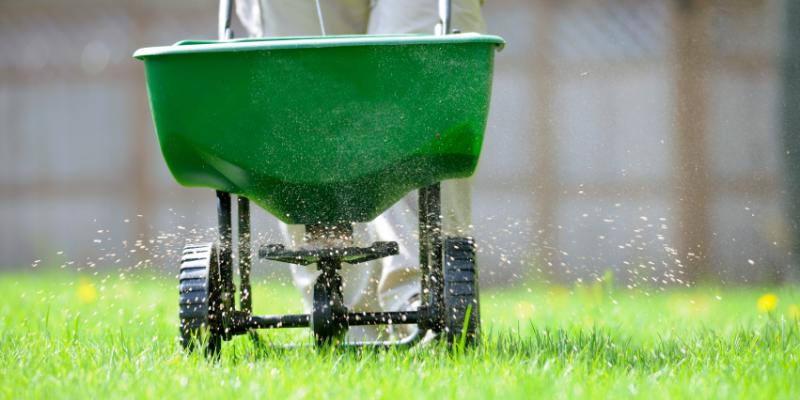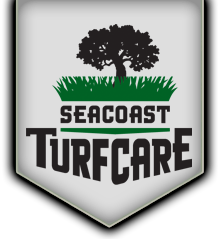
Fertilizing and Sod: Lawn Care Tips for Beautiful Yards
Keeping your lawn happy and healthy isn’t just something we do to make your house look good. Healthy lawns carry an abundance of benefits – from improving air quality and reducing heat to generating oxygen. That’s why it is important that we make sure that we’re keeping those lawns happy and healthy. One of the best ways to keep your grass in tip-top shape is to fertilize, and Fall is the time to do it! Today, we’re going to discuss everything you need to know about fertilizing your lawn late in the fall and why you should do it, as well as whether you should use sod or seeding for your lawn.
Why Fertilize Your Lawn in the Fall?
When you think about the fall being the best time of year to fertilize, most would think of it as a little counter-intuitive. After all – lawns grow and thrive in the spring and summer, right? You’d be surprised. The fall is actually the best time to fertilize your lawn because its conditions offer an ideal setting for grass to regain its strength. The morning dew delivers moisture that helps the ground absorb fertilizer better and gives it a chance to build stamina before the cold temperatures of the winter set in. Additionally – stronger, deeper root growth almost always leads to a healthier and greener lawn in the spring. While yes – the spring is when everything grows – it’s the fall that’s the best time to feed your lawn. Fertilizer gives it the little extra oomph it needs to succeed once the prime growing season sets in.
When Should I Apply Fertilizer?
Your best bet is to apply fertilizer about 2-3 weeks before the ground freezes. It’s a good idea to do a little research and figure out when the first frost date will be in your area and do it then. In the past, the end of October has always been that time, but with climate change, that has been getting pushed further and further back. Even here on the Seacoast area in New Hampshire, the ground hasn’t totally frozen yet – so there’s still time.
How Do I Fertilize My Lawn?
You’ll want to apply your fertilizer in the morning or the early evening as both times will allow you to avoid warmer daytime temperatures that might work against you and the fertilizer. Also, be sure to mow your lawn beforehand and leave some clippings behind. This will help the soil absorb the fertilizer better and help better maintain temperatures to assist in root growth.
The only thing you want to make sure you don’t do is to fertilize before heavy rain. When it rains, you get runoff and that can be problematic for a variety of reasons – but most of all – it means wasted time and effort on your part. Just be sure you check your forecast before application. Simply put – you always want to fertilize your lawn in dry conditions always.
Should You Use Sod or Seeding on Your Lawn?
A common decision that homeowners face when giving their lawn a makeover is whether they should use grass or sod. Both will take an investment of both your time and money – but what’s the risk associated with choosing sod or electing to use grass seed?
Benefits of Sod
Here are a few of the reasons sod can be a big winner for you and your lawn:
Fast Growing
Sod is great for making sure that exposed soil doesn’t erode. In addition, it can help provide more direction of rain run-off and improve drainage in areas where grass seed typically gets washed out.
Flexible
Sod can be planted at any time so long as the ground isn’t frozen. Seed, by contrast, can only be planted during certain periods where there aren’t extreme shifts in temperature.
Reliable
A big detractor to using grass seed is that it tends to dry out, can get blown out of place by the wind, or even washed out due to rain. Sod is already established and will stay in place exactly where you want it.
Time-Saving
Once the sod has been installed and watered for a few weeks, you can walk on it and actually take advantage of its presence. With seed – there’s a much longer wait and a much higher risk that it doesn’t take to the soil.
You Have a Margin For Error
Well-maintained and properly maintained sod tends to establish a root structure far more quickly than grass seed does, but also presents significantly less risk of failure. While it’s not recommended, if you forget to water sod for a day during its installation period and get pulled away from your home for whatever reason for a brief period of time, it still has a high chance of success.
What Are The Downsides of Sod?
Some reasons as to why you might want to hold off on using sod and perhaps give grass seed a closer look.
It’s a lot more expensive
Simply put, sod is far more expensive than grass seed. For some, the cost may not even be an option depending on how much of your lawn you’re looking to redo. Seed is far less expensive, but it comes with its own share of maintenance challenges.
Installation
Installing sod isn’t as easy as uncovering some dirt and flopping a roll down. A proper installation can require fertilizer, topsoil, and the like – so you may want to call in a professional lawn care technician to make sure you’re doing things the right way. It’s not as easy as sprinkling seeds.
Variety
Depending on the look and feel that you’re going with, seed might be your best option simply because there’s a lot more variety in terms of what you can choose. Sod generally comes in only a few species of grass and depending on what you want for your lawn, grass seed might be your best bet – especially if you’re going for something unique. At the very least, you’ll have a lot more options to choose from.
Replacement
One of the frustrating aspects of laying sod down is that sometimes you can seemingly do everything the right way and random sections of it won’t take root for whatever reason. Replacing these sections will cost you more money and even if they can take – can sometimes look out of place for a period of time.
Professional Lawn Care In The Seacoast
Regardless of what you choose – grass seed or sod – it’s important that you weigh the options so that you choose the solution that’s best for your specific situation. As we’ve shown here, there’s a lot to think about – but know at the end of the day that your dedication and ability to go the extra mile to make sure the right things are being done to give your lawn the best start possible; that’s what’ll make the biggest difference. If you are in need of more assistance contact Seacoast Turf Care as we offer expert advice and services including fertilization, aeration, soil amendments, and more!


